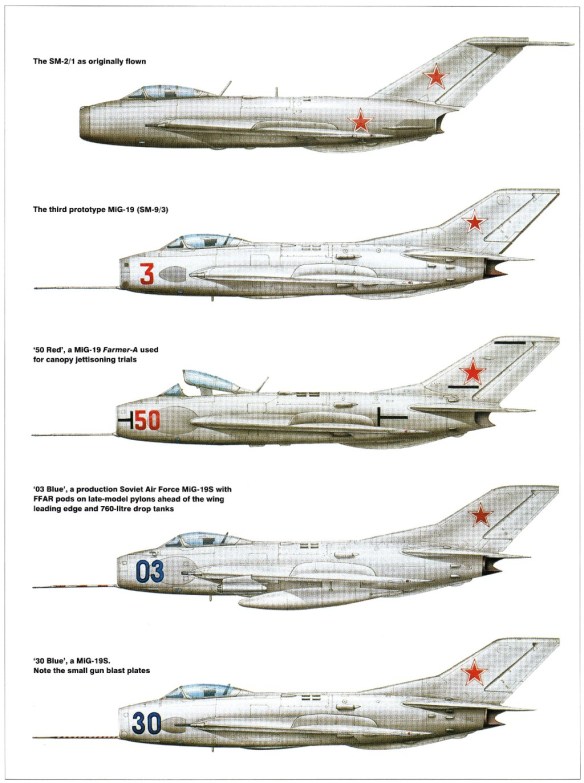From 1951 to 1956, the MiG-15 was supplanted in production with a modernized version, the MiG-17. Neither the MiG-15 nor the MiG-17 was capable of supersonic flight, which was finally achieved by the MiG-19 series (in production from 1954 to 1961). Only 3,700 MiG-19s were produced; it was sold widely, but it had the misfortune to appear between the exceptional and long-lived MiG-17 and the equally successful MiG-21.
The MiG-19 was a counter to the F-100, and was arguably the worst fighter to come from the MiG stable since WWII. It was a nasty airplane, given to flameouts when the guns were fired, and a real dog in combat. Having many innovations compared with the MiG-17, the MiG-19 was the Russian equivalent of the F-100 Super Sabre. Both aircraft were marginally capable of attaining supersonic speed in level flight, the MiG-19 having achieved this as the first Soviet supersonic interceptor in December 1952 – four months ahead of the F-100. Like the North American fighter, it initially suffered from control ability problems at high speeds. Both aircraft were given larger vertical tail surfaces to improve stability, and both featured one-piece stabilators instead of elevators – an innovation in Russia, hence the “S” in MiG-19S.
The MiG-19’s importance in the evolution of MiG fighters far outweighed its brief Soviet air force (VVS) career. Skilled MiG-17 pilots were sometimes able to make brief supersonic dashes, but a genuine supersonic fighter was needed. As early as June 1950 Josef Stalin had told the heads of Russia’s aircraft industry that he wanted a twin-engined fighter that could be manufactured both as a radar-equipped all-weather interceptor and as a supersonic tactical fighter. Clearly, he was well ahead of Robert S. McNamara’s 1960s ideas of “commonality” in the USA.
Mikoyan saw that an increase in wing sweep had made his MiG-17 faster than the MiG-15, so he opted for a 55-degree sweep in the SM-2 prototype that was to pioneer Soviet supersonic flight. With a high T-tail, two Mikulin AM-5F engines and tail surfaces swept back to match the wing, the aircraft was barely supersonic. It also exhibited severe stability problems. The SM-2 was followed by the SM-9/1, which featured a fuselage-mounted tailplane, two afterburning AM-9B engines and three NR-23 cannons.
On its first flight on January 5, 1954, the new fighter exhibited vastly improved handling over the SM-2, and it was soon making regular supersonic flights. Indeed, tests showed it to be 205 knots faster than the MiG-17 at 32,800ft, and capable of attaining a ceiling of 51,500ft – 3,000ft higher than the “Fresco”. Designated the MiG-19 for service production, the aircraft was ordered for the VVS on February 17, 22 1954. Testing continued with the SM-9/2 and SM-9/3, proving the effectiveness of the “slab” tailplane layout and introducing a spoiler system to improve lateral control, as well as many refinements to the flight controls and their servos.
The SM-9/3 – dubbed “3 Red” – tested the production armament of three NR-30 30mm cannon, whose combined weight of fire (40lbs per second) was twice that of three NR-23s. Like the MiG-17, the SM-9/3 also had two underwing hardpoints to carry a 550lb bomb each. This was the pattern aircraft for MiG-19S “Farmer-C” production, with RD-9B engines (one of the first powerplants credited to designer Sergei K. Tumansky) each developing 7,164lbs thrust – almost twice that of the MiG-17’s VK-1F engine. Some gun-gas ingestion engine surges occurred when the nose cannon was fired, and it was found that the engines flamed out in a spin.
While the aircraft prepared to enter service, OKB MiG worked on its galaxy of experimental sub-variants, of which the MiG-19P and MiG-19PM were each produced in greater numbers than the MiG-19S (443, 369 and 317 units, respectively). Production of the former began in 1957 after only two years of MiG-19S manufacturing. Both sub-types were designed to use K-5M semi-active, air-to-air missiles as Soviet designers followed their Western counterparts into the missile age. Four were carried on underwing pylons, and they were guided by the fighter’s RP-5 Izumrud-2 radar. Two NR-30 cannon were retained, but only in the MiG-19P. Performance suffered from the drag of the missiles, and the flight control system in the MiG-19P/PM proved to be less reliable than that fitted in the MiG-19S.
